
The Solar-Terrestrial Centre of Excellence (STCE) is a collaborative network of the Belgian Institute for Space Aeronomy, the Royal Observatory of Belgium and the Royal Meteorological Institute of Belgium.
 |
Published by the STCE - this issue : 16 Oct 2014. The Solar-Terrestrial Centre of Excellence (STCE) is a collaborative network of the Belgian Institute for Space Aeronomy, the Royal Observatory of Belgium and the Royal Meteorological Institute of Belgium. |
| Archive of the newsletters | Subscribe to this newsletter by mail |
This year, the Belgian Institute for Space Aeronomy (BISA) celebrates its 50th anniversary. On that occasion, an Open Door was organized during the weekend of 11 and 12 October (http://50.aeronomie.be/index.php). Despite the bad weather on Saturday, an estimated 7000 people visited the Space Pole. This can be considered as a big success. The STCE participated extensively with numerous activities.
An estimated 2000 people visited the Solar Dome. About 10 scientists took turns in guiding groups of about 15 people each. First, there was a short explanation on the sunspot number, the solar cycle and solar eruptions. Then, in a separate room, a short demo was given on the solar images taken by the solar telescopes at Uccle. Obviously, the highlight of the tour was the visit of the solar telescopes and -weather permitting- realtime observation of the Sun and the sunspots on a projected solar image. The tours lasted 10-12 minutes and were mostly given in French and Dutch, but there were also a few tours in English and even Spanish, courtesy of our visiting international scientists. Quite a few people stayed after the tour asking additional questions to the tour guides.
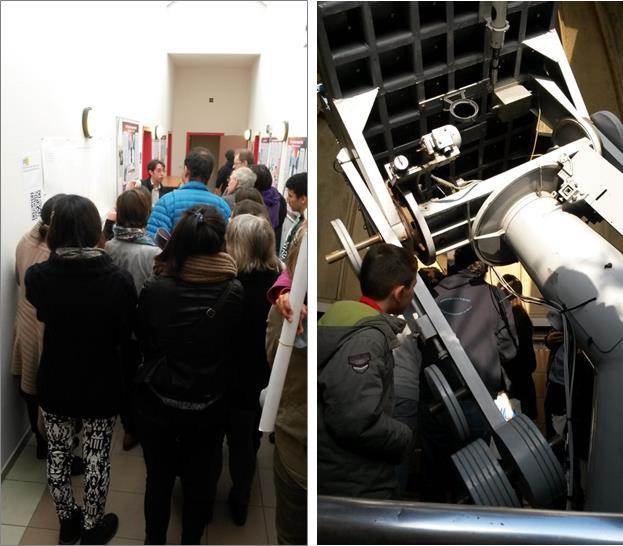
In this tent, scientists gave talks during the entire open door weekend. Each lecture lasted for about 20 minutes and was followed by a 5-minute Q-and-A-session. Emphasis was on solar activity and its influence on Earth, but also other themes were addressed such as the planets, earthquakes (seismology) and the ionosphere. Links to the various presentations can be found at the end of this Newsletter ("New documents in the ESWP repository"), or directly at the repository of the European Space Weather Portal (http://www.spaceweather.eu/en/repository). An estimated total of 350 visitors attended the lectures, with the lectures in French drawing the largest audiences - often a full house!
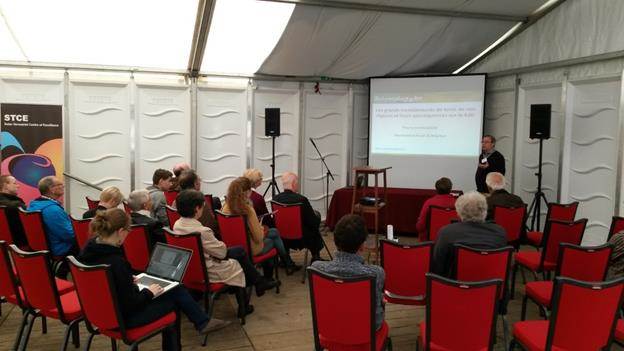
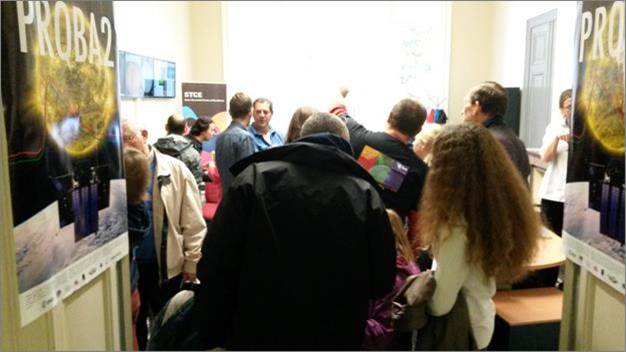

During this week 3 M-class flares and 26 C-class flares were reported by GOES.

The strongest flare of the week was the M1.4 flare (peaking at 01:58 UT) on October 09. A few minutes before the peak of the M1.4 flare, the first of this serie of 3 M-flares peaked. The flare was comparable: M1.3. These confined flares (without associated CME) originated from the Catania sunspot group 67 (NOAA AR 2182) which was the source of all three M-class flares and numerous C-class flares. In a close up of the x-ray flux at the time of the M1.3 and M1.4 flare, you see that both occurred closely to each other in time.
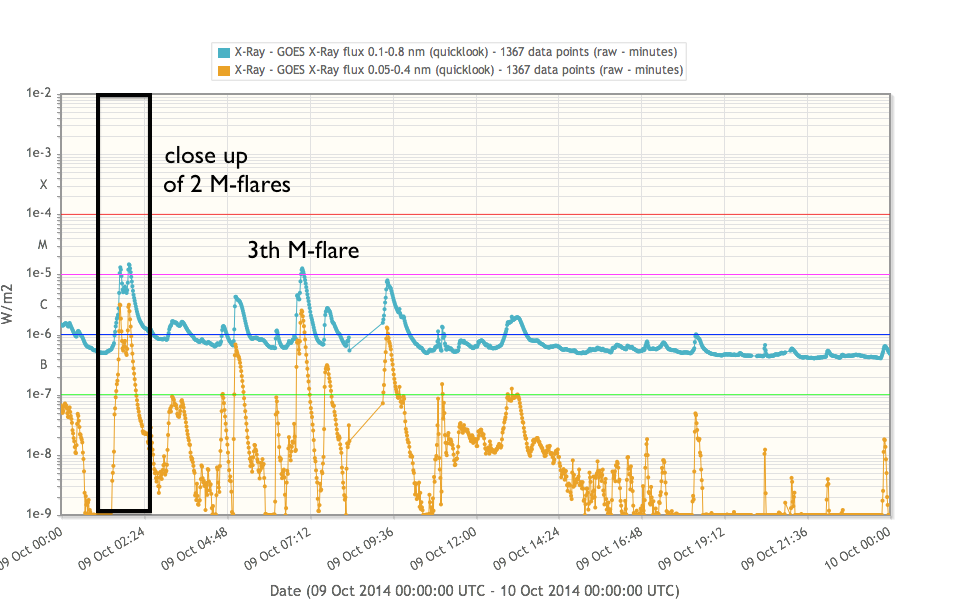
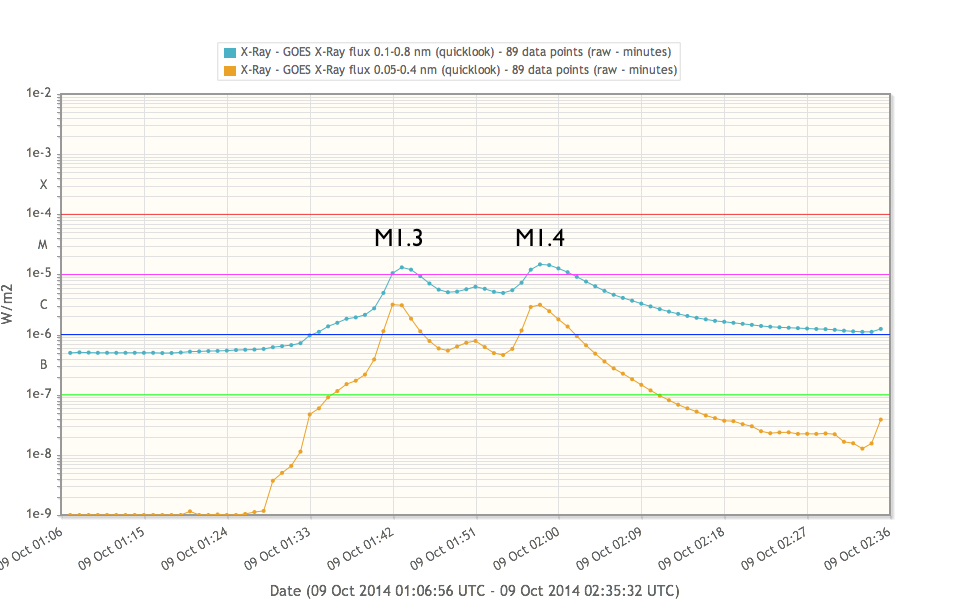
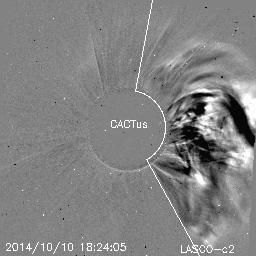
| DAY | BEGIN | MAX | END | LOC | XRAY | OP | 10CM | TYPE | Cat | NOAA |
| 09 | 0130 | 0143 | 0147 | M1.3 | F | 67 | 2182 | |||
| 09 | 0154 | 0158 | 0202 | M1.4 | 67 | 2182 | ||||
| 09 | 0648 | 0659 | 0706 | M1.2 | N | 67 | 2182 |
| LOC: approximate heliographic location | TYPE: radio burst type |
| XRAY: X-ray flare class | Cat: Catania sunspot group number |
| OP: optical flare class | NOAA: NOAA active region number |
| 10CM: peak 10 cm radio flux |
The solar wind speed decreased from slightly above 400 km/s on October 06 to 340 km/s on October 07. The remaining days, the solar wind speed stayed around 350 km/s.
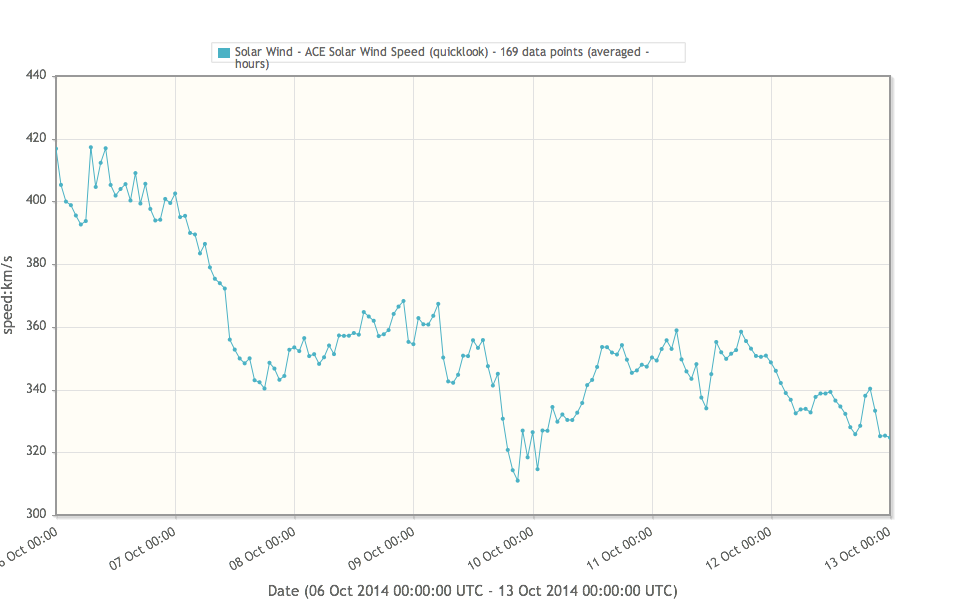
Due to the sector change on October 08 at about 05:30 UT, the interplanetary magnetic field magnitude was slightly elevated, up to the values of about 10 nT. The elevated value of the interplanetary magnetic field, which persisted during almost three days, was probably due to the sector change.
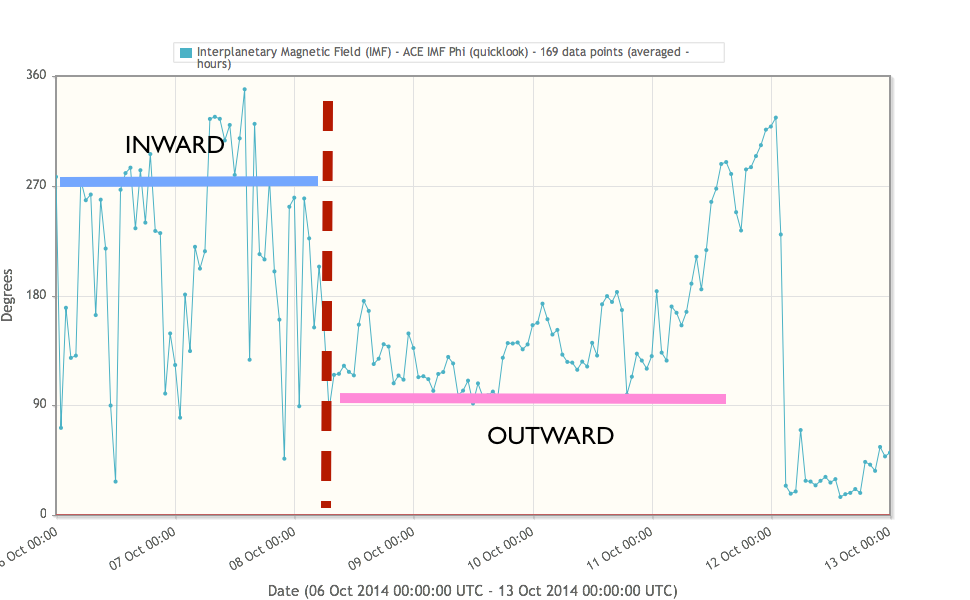
The Bz component of the interplanetary magnetic field had numerous long lasting intervals of negative values (about -7 nT), starting from the morning of October 08 until the noon on October 11. Due to the negative values of the Bz component we had quiet to active geomagnetic conditions on October 08 and October 09 (K=4 reported by local station at Dourbes and Kp=4 reported by NOAA) and quiet to unsettled geomagnetic conditions during the rest of the week.
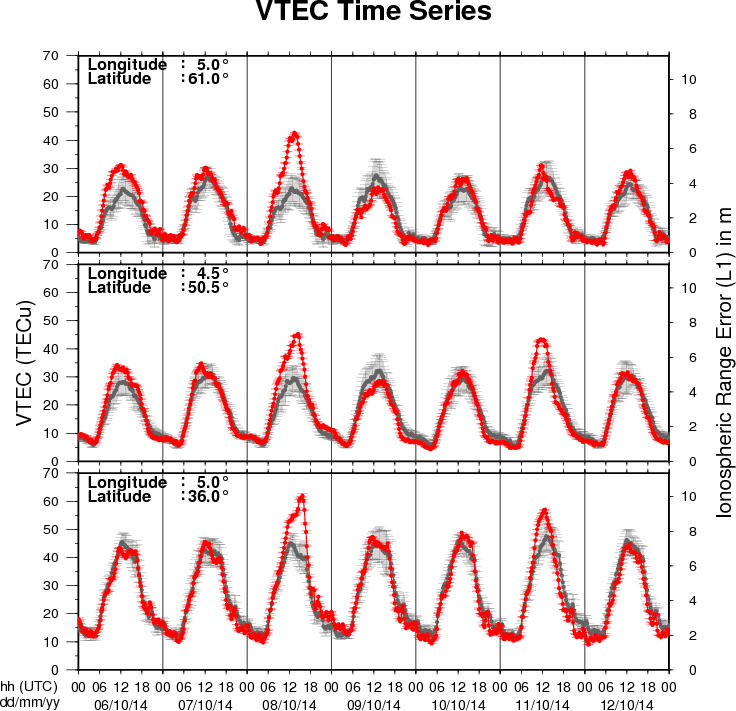
The figure shows the time evolution of the Vertical Total Electron Content (VTEC) (in red) during the last week at three locations:
a) in the northern part of Europe(N61°, 5°E)
b) above Brussels(N50.5°, 4.5°E)
c) in the southern part of Europe(N36°, 5°E)
This figure also shows (in grey) the normal ionospheric behaviour expected based on the median VTEC from the 15 previous days.
The VTEC is expressed in TECu (with TECu=10^16 electrons per square meter) and is directly related to the signal propagation delay due to the ionosphere (in figure: delay on GPS L1 frequency).
The Sun's radiation ionizes the Earth's upper atmosphere, the ionosphere, located from about 60km to 1000km above the Earth's surface.The ionization process in the ionosphere produces ions and free electrons. These electrons perturb the propagation of the GNSS (Global Navigation Satellite System) signals by inducing a so-called ionospheric delay.
See http://stce.be/newsletter/GNSS_final.pdf for some more explanations ; for detailed information, see http://gnss.be/ionosphere_tutorial.php
Start : 2014-11-12
This conference aims to bring together researchers, engineers,
users in the area of Big Data in the Space sector.
The focus is on the whole data lifecycle, ranging from data
acquisition by spaceborne and ground-based sensors to data
management, analysis and exploitation in the domains of Earth
Observation, Space Science, Space Engineering, Space Weather,
etc.
Special emphasis will be put on highlighting synergies and
cross-fertilization opportunities from domains like Climate Change,
Solid Earth Science, Planetary Sciences, Life Science,
Astrophysics, High Energy Physics, Social Sciences, etc.
We expect this conference to:
* contribute towards a common "Big Data from Space" scientific
and programmatic framework
* widen competences and expertise of universities, labs and
industrial actors
* foster networking of experts and users towards better access
and sharing of data, tools and resources
* leverage innovation, spin-in, spin off of technologies, and
business development arising from research and industry
progress
Website:
http://congrexprojects.com/2014-events/BigDatafromSpace/objectives
Start : 2014-11-17 - End : 2014-11-21
The 11th Edition of the European Space Weather Week will take
place on 17-21nd November 2014 in Liège, Belgium.
The ESWW will again adopt the central aim of bringing together
the diverse groups in Europe working on different aspects of Space
Weather. This includes but isn't limited to the scientific
community, the engineering community, applications developers,
service providers and service end users.
The meeting organisation is coordinated by the Belgian
Solar-Terrestrial Centre of Excellence (STCE), ESA and the Space
Weather Working Team. The local organisation is done by the
STCE.
Website:
http://www.stce.be/esww11/
Start : 2014-12-15 - End : 2014-12-19
The AGU Fall Meeting is the largest worldwide conference in the
geophysical sciences, attracting more than 22,000 Earth and space
scientists, educators, students, and other leaders. For 46 years,
energized and passionate Earth and space scientists from around the
world gather at the AGU Fall Meeting to connect with colleagues,
broaden their knowledge base, and embrace the joy of science. The
2014 meeting takes place Monday 15 - Friday 19 December 2014.
Several sessions about space weather are foreseen:
*
When and Why Does Space weather Forecasting Fail?
*
Addressing Operational Space Weather Needs
*
Near Real Time Data for Earth Science and Space Weather
Applications
*
Understanding Hemispheric Asymmetry and Space Weather
*
Connection of Solar Events With the Variability of Space
Environments
*
Bz from the Sun to the Earth: Observations and Modeling
*
Solar Sources and Heliospheric Consequences of Coronal Mass
Ejections in Solar Cycle 24
*
Advances in Ionospheric Forecasting - Modeling, Observations, and
Validation
Abstract Submission Deadline: August 6, 2014
Website:
http://fallmeeting.agu.org/2014/
Start : 2015-04-20 - End : 2015-04-24
This gathering was born out of the desire to collect in one
place the latest technologies required for advancement of science
in the discipline of Solar and Space Physics. In doing so, it was
recognized that the two 1998 volumes of 'Measurement Techniques in
Space Plasmas' (Particles and Fields) have been a valuable
reference and resource for advanced students and scientists who
wish to know the fundamentals of measurement techniques and
technology.
Website:
https://mtssp.msfc.nasa.gov/
Start : 2015-06-22 - End : 2015-07-02
We invite contributions on novel inversion methods with
application across the geosciences. Of particular interest are 3D
imaging, joint inversion of geodetic, geophysical and geochemical
datasets, and multi-disciplinary interpretation approaches such as
integration of gravity, EM and seismic data or thermo-mechanical
modelling studies constrained by physical parameters.
Modelling of Space Weather Effects: Solar, Magnetospheric and
Earth Resistivity Constraints (IAGA, IAMAS)
In this symposium we welcome contributions on all aspects of the
modelling of space weather and its effects, from the Sun to Earth.
This includes the modelling of the various interactions between
travelling solar storms and the solar wind, magnetosphere,
ionosphere and solid Earth and the validation of models through
measurements. Contributions on models developed to aid end-users,
such as satellite and power grid operators, survive the impact of
space weather are also encouraged.
Website:
http://www.iugg2015prague.com/joint-inter-association-symposia.htm#JA
Presentation, in French given at the open doors of the Space Pole, Brussels, Belgium, 2014
http://www.spaceweather.eu/en/repository/show?id=542
Presentation, in Dutch given at the open doors of the Space Pole, Brussels, Belgium, 2013.
http://www.spaceweather.eu/en/repository/show?id=543
Presentation, in French given at the open doors of the Space Pole, Brussels, Belgium, 2014
http://www.spaceweather.eu/en/repository/show?id=544
Presentation, in French given at the open doors of the Space Pole, Brussels, Belgium, 2014
http://www.spaceweather.eu/en/repository/show?id=545
Presentation, in French given at the open doors of the Space Pole, Brussels, Belgium, 2014
http://www.spaceweather.eu/en/repository/show?id=546
Presentation, in Dutch given at the open doors of the Space Pole, Brussels, Belgium, 2014
http://www.spaceweather.eu/en/repository/show?id=547
Presentation, in French given at the open doors of the Space Pole, Brussels, Belgium, 2014
http://www.spaceweather.eu/en/repository/show?id=549
Presentation, in Dutch given at the open doors of the Space Pole, Brussels, Belgium, 2014
http://www.spaceweather.eu/en/repository/show?id=548
Presentation, in Dutch given at the open doors of the Space Pole, Brussels, Belgium, 2014
http://www.spaceweather.eu/en/repository/show?id=550
Presentation, in Dutch, given at the open doors of the Space Pole, Belgium, 2014
http://www.spaceweather.eu/en/repository/show?id=551